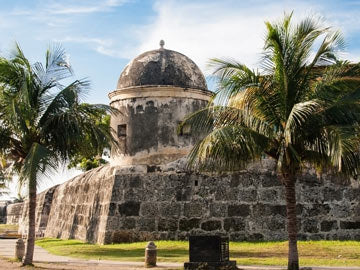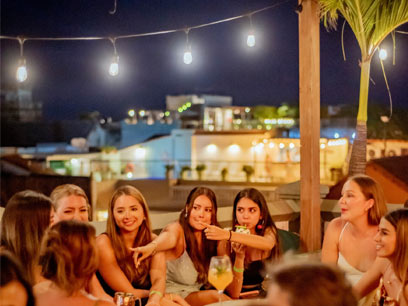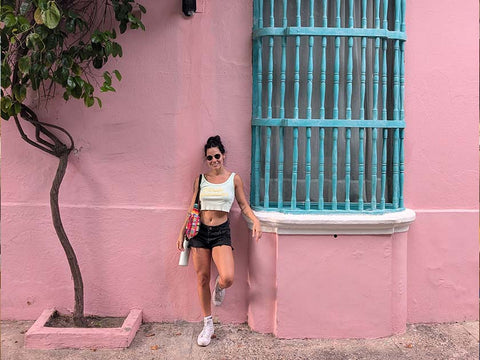If you plan to spend time in Cartagena, Colombia, one of the many memorable sights you will see are the Afro-Colombian women selling fruit and typical sweets in the plazas and streets in the walled center of this 16th century town. The women wear their typical-style, brightly colored dresses, posing for photos and stealing the hearts of tourists visiting this colorful Colombian gem each day. But most people don’t know much more about these women, past the sweets and fruit they sell. These women, called Palenqueras, come from a town called San Basilio de Palenque, which is the first free town in America.
Brief History:
Palenque is located in the department of Bolívar, a little more than an hour south of Cartagena. San Basilio de Palenque was founded by Benkos Biohó, who was brought to current-day Colombia by the Spaniards during the 16th century. After escaping, he and other slaves fled and began setting up the community that we know today as San Basilio de Palenque. These slaves tried to help free other slaves arriving to Cartagena and had great success, helping many slaves arrive safely to their community, a safe haven. In 1691, the Spanish Crown issued a decree stating that the citizens of San Basilio de Palenque were free. This decree meant that these people were the first free Africans in the Americas and this was the first free settlement. The word palenque means “walled city” and many of these “palenque” communities were set up by former slaves in many different countries.
Of all of the palenques that existed, San Basilio de Palenque, in Colombia, is the only one that still exists today. In 2005, San Basilio de Palenque was declared a Masterpiece of the Oral and Intangible Heritage of Humanity by UNESCO.
Currently, about 4000 inhabitants live in this town while many others have moved to nearby bigger cities, such as Cartagena or Barranquilla. A unique thing about San Basilio de Palenque is that they developed their own language that is still in use today, even though the rest of Colombia speaks Spanish. This language is called Palenquero and it is a mix of African Bantu, Spanish, French, English and Portuguese. This language along with many other customs from African heritage are still a large part of San Basilio de Palenque’s community today.
How do i get to San Basilio del Palenque and what will I see?
Do not expect to find architectural gems like in Cartagena, the essence of this town is in its roots and the immaterial legacy that has been preserved and fights to remain in the future.
To get to Palenque, you can travel to the bus terminal in Cartagena and catch a bus from there, though it is difficult to do so, and then upon arrival to one of two towns outside of Palenque (San Juan or Mahates), you must catch a moto taxi into the town. An easier and more comfortable option is to book a tour that includes transportation, a tour with a local tour guide and lunch, so you can maximize your time in Palenque and really enjoy the experience, while learning about the culture and history from someone who really understands it.
The best way to see the town of Palenque is to go with a local guide who can show you all the ins and outs of their community, giving you a more authentic experience. The local guides have so much information and details about the history of this amazing town. Local tours can be done in both Spanish and English, with a bit of Palenquero thrown in for you to learn and practice throughout your tour.
There are two tour options for visiting San Basilio de Palenque, the regular tour and the private tour:
With the regular tour, which only leaves on Sundays, you will leave Cartagena (Getsemani) around 8:30 am, travel to San Basilio de Palenque and arrive around 10 am. There, you will be met by your bilingual tour guide, who will take you to many important places and landmarks throughout the town. You will learn a great deal of history about this town and experience unique visits with Rafael Cassiani Cassiani, a singer from Palenque and Rosalina la Rezandera, who offers different healing practices to the community. Your tour guide will take you to numerous different sites such as the main town square, where you will find the Benkos Biohó statue, Afroneto music house, where you can sign your name as most visitors to the town do, and to the town’s cultural center. You will also have the chance to purchase Ñeque, a traditional alcohol created in San Basilio de Palenque. After this tour, you will say goodbye to your tour guide and head out for lunch before returning to Cartagena between 3 and 4 pm. This tour can be purchased here
The private tour to San Basilio de Palenque includes all of of the above (except lunch), but with a bit more flexibility. The private tour can be scheduled for any day of the week, as long as two or more people are signed up. As participants in the private tour, you will also receive two special souvenirs from Palenque and a more personalized experience with your tour guide and the Palenque community. To book your private tour, click here.
What to Bring:
To have the most comfortable experience in your tour to San Basilio de Palenque, make sure to wear comfortable clothes and shoes, bring lots of sunscreen and a fan or umbrella (there isn’t a lot of shade and the sun is strong) and make sure to bring your camera so you can take a lot of photos of this historical and interesting town. Also, make sure to bring water, or if your prefer, there are several stores in town where you can buy snacks and water throughout the day as well.
San Basilio de Palenque is full of history and culture and a place you won’t want to miss during your visit to Cartagena!
Expert Tip: In October, San Basilio de Palenque is home to the Festival de Tambores y Expresiones Culturales, or Festival of Drums and Cultural Expression. If you can make it for this three day festival, you can have an authentic experience in one of Colombia’s unique musical festivals.





